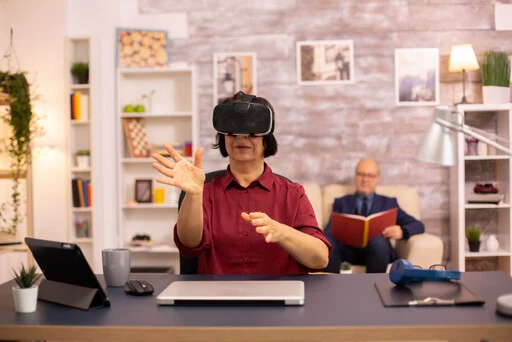Step into the future with confidence as we unveil “Tech Trends 2024: A Comprehensive Guide to What’s Next.” As technology continues to permeate every aspect of our lives, understanding the latest trends is essential for both businesses and individuals alike. From cutting-edge developments in cybersecurity to the integration of augmented reality (AR) in everyday experiences, this guide illuminates the path forward in our tech-driven world. Join us as we decode the complexities of modern technology and anticipate the game-changing innovations on the horizon.
Table of Contents
1. The Rise of Artificial Intelligence (AI)
Artificial Intelligence (AI) is transforming technology as we know it. From virtual assistants to advanced algorithms, AI is everywhere, making our lives easier and more efficient. This rise of AI marks a significant shift in how we interact with technology, promising to revolutionize industries and enhance our daily lives.
a. Understanding the AI Revolution
The AI revolution is all about machines learning and adapting like humans. This means AI systems can continuously improve, making them invaluable across various fields. By grasping the basics of AI, we unlock its potential to transform technology and society for the better.
b. Applications and Implications of AI
AI’s applications are vast, impacting everything from healthcare to finance. It helps doctors diagnose illnesses, optimizes investment strategies, and much more. However, along with its benefits come ethical concerns. Balancing innovation with responsibility is key to ensuring AI serves us positively while addressing potential drawbacks.
2. The Internet of Things (IoT) in Action
The Internet of Things (IoT) is changing how we use technology. It connects everyday objects to the internet, making them smarter and more efficient. With IoT, we can control our devices remotely and get real-time updates, making our lives easier.
a. Exploring the Connected World of IoT
IoT creates a connected world where devices work together to improve our lives. From smart homes to smart cities, IoT technology is everywhere, making things more convenient and efficient. By exploring this connected world, we uncover new ways to enhance our lifestyle with seamless connectivity.
b. IoT in Industry: Transforming Businesses
In the business world, IoT is revolutionizing operations. Companies use IoT devices to monitor processes, track inventory, and optimize resources. This helps businesses become more productive and competitive in today’s fast-paced environment.
c. IoT Security: Safeguarding Data in a Connected Environment
As IoT devices become more common, security becomes crucial. Protecting data from cyber threats is essential to maintain trust and safety in a connected world. By prioritizing IoT security measures, we can ensure that the benefits of IoT technology outweigh the risks.
3. Augmented Reality (AR) and Virtual Reality (VR) Integration
Augmented Reality (AR) and Virtual Reality (VR) are blending into our tech world seamlessly, changing how we engage with digital content. AR adds digital elements to our real world, while VR immerses us into entirely digital environments. Their integration promises to revolutionize industries and elevate our tech experiences.
a. Immersive Experiences: The Power of AR and VR
AR and VR offer powerful immersive experiences. AR enhances our reality with digital overlays, while VR transports us to virtual worlds. These technologies redefine how we interact with technology, offering new levels of engagement and enjoyment in our daily lives.
b. AR and VR Applications Across Industries
AR and VR have applications across many industries. In healthcare, AR assists in surgeries, and VR aids in medical training. In education, AR enhances learning, and VR provides virtual field trips. These technologies are reshaping industries and enhancing our tech-driven lifestyle.
c. Overcoming Challenges: Adoption and Integration of AR/VR Technologies
Despite their potential, AR and VR face challenges in adoption and integration. Technical limitations and high costs hinder widespread use. However, as technology advances and costs decrease, we’re seeing more adoption. Overcoming these challenges requires collaboration to ensure these technologies enrich our tech experiences effectively.
4. The Future of Cybersecurity
The future of cybersecurity is vital as technology evolves. Protecting our data and privacy in an increasingly digital world is crucial. With advancing technology, cybersecurity measures must adapt to counter new threats and ensure a secure online environment for everyone.

a. Emerging Threats in the Digital Age
In the digital age, new threats emerge constantly, posing challenges to cybersecurity. Cybercriminals use tactics like phishing and ransomware to exploit vulnerabilities in technology. Understanding these threats is essential for staying safe and protecting our digital lives.
b. Innovations in Cybersecurity: Protecting Data and Privacy
Innovations in cybersecurity help keep our data and privacy safe in a technology-driven world. Advanced encryption, biometric authentication, and AI-driven threat detection enhance cybersecurity defenses. Embracing these innovations strengthens our security against evolving threats, ensuring a safer digital lifestyle.
c. Cybersecurity Governance: Strategies for a Secure Future
Cybersecurity governance is crucial for ensuring a secure future in technology. By implementing policies and regulations, we can mitigate cyber risks and protect against attacks. Collaboration between governments, businesses, and cybersecurity experts is essential for building a resilient technology ecosystem. Prioritizing cybersecurity governance ensures a safer digital landscape for all.
5. Sustainable Technology Solutions
Sustainable technology solutions aim to address environmental issues using innovative approaches. By integrating eco-friendly practices into technology, we can reduce our environmental impact and promote a healthier planet for future generations.
a. Addressing Environmental Challenges with Technology
Technology offers solutions to environmental challenges like climate change and pollution. Renewable energy sources such as solar and wind power provide clean alternatives to fossil fuels, while advancements in waste management technologies help minimize environmental impact.
b. Green Technology Innovations: Towards a Sustainable Future
Green technology innovations prioritize sustainability by offering energy-efficient appliances, eco-friendly materials, and electric vehicles. By embracing these innovations, we can reduce reliance on finite resources and create a more environmentally friendly future.
c. Corporate Responsibility: Driving Sustainability through Technology
Corporate responsibility drives sustainability by integrating eco-friendly practices into business operations and investing in sustainable technologies. By prioritizing sustainability, companies can contribute to a healthier planet and improve the well-being of communities worldwide.
6. Conclusion
In conclusion, technology shapes our world in significant ways, offering both opportunities and challenges. By embracing responsible use of technology, we can ensure its benefits are felt by all, creating a brighter future for generations to come.
a. Anticipating Tomorrow: Reflections on Tech Trends 2024
Looking back at the tech trends of 2024, it’s clear that technology continues to transform our lives. From AI to IoT, these trends redefine how we interact with the world. Embracing these changes allows us to adapt and thrive in an ever-evolving technological landscape.
b. Embracing Change: Charting a Course for the Future
As we look to the future, embracing change is key. By staying adaptable and open-minded, we can navigate the challenges and opportunities that technology brings. Embracing innovation ensures we shape a prosperous and sustainable future for all.




















































2 Comments
Great.😊
Thank you